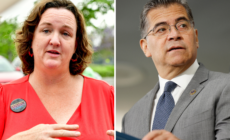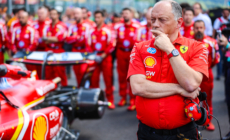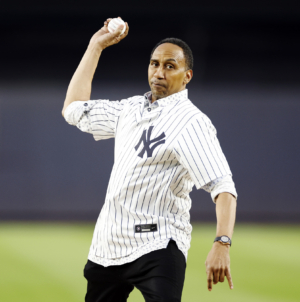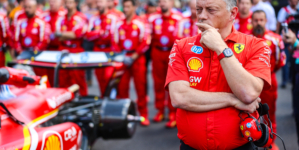-
ESPN’s Stephen A. Smith Calls for Bryce Harper Suspension - 30 mins ago
-
Canada to Recognize Palestinian State at the U.N. General Assembly - 40 mins ago
-
California Governor Race: Leading Candidates as Kamala Harris Opts Out - about 1 hour ago
-
A dozen Democrats sue ICE for preventing detention center oversight visits - about 1 hour ago
-
U.S. Hits Brazil With 50% Tariffs and Sanctions in Sharp Escalation - about 1 hour ago
-
Ferrari F1 Leadership Talks Heating Up as Vasseur’s Future Stays Undecided - 2 hours ago
-
Kamala Harris move leaves one door open while closing another - 2 hours ago
-
Brown University Makes a Deal With the White House to Restore Funding - 2 hours ago
-
Hysterics as Woman Comes Home to Find Dog Locked in Crate—Along With a Note - 2 hours ago
-
L.A. City Council bans N-word and C-word at meetings - 3 hours ago
New York Mayor’s Race Shows Us a Better Way To Run Elections | Opinion
We all know American politics needs a redesign. Too many politicians are unaccountable to the voters and act like they know it. We want more choices and consensus, but have been ground down by toxic campaigns.
The good news is that change is not only possible but already happening, if you know where to look. Anyone looking for a good example of progress that matters should check out the Democratic mayoral primary in New York City. We’ll get a nominee who represents a majority of us, and we’re getting a campaign where candidates are working together instead of just tearing each other down.
This year marks the second time New York City voters will select mayoral nominees with ranked-choice voting (RCV), and that has made a huge difference. You don’t have to be a math person to see how RCV has created different incentives and made the campaign better. Take it from someone who has run in races with and without ranked-choice voting: It’s working for New York and would do the same in cities and states across the nation.
Our primary is the kind of race that would be a mess without RCV: 11 candidates, representing a range of ideologies, backgrounds, and neighborhoods. In most places, such crowded primaries could be won with as little as a quarter of the vote as candidates go on a negative blitzkrieg against anyone they see as a threat. That drives up the candidates’ negatives and everyone else’s frustration.
Such negativity won’t work here. In a ranked-choice election, voters have the power to name their second and third choices. If no one has 50 percent of voters’ first choices, the lowest candidates are dropped. If your first choice is eliminated, your vote counts for your second choice. This process continues until someone wins a majority. Essentially, we turned the primary into an instant runoff that everyone can participate in, and that produces a winner with the widest and deepest support.
This explains why the New York mayoral race is seeing campaigns that otherwise might look—well, a little weird.
Queens assemblyman Zohran Mamdani—running second behind former governor Andrew Cuomo in most polls—urged his supporters to donate to one of his opponents, council speaker Adrienne Adams. Mamdani and Brad Lander, running third, cross-endorsed each other two weeks ago and encouraged their followers to rank them one-two, in whatever order. Mamdani, Adams, Lander, and Zellnor Myrie have locked arms and done multiple campaign events together.
All because voters can express support for multiple candidates. In a ranked-choice system, you can’t write off voters who support another candidate—instead, it pays to talk to them, explain where you have common ground with their first-choice candidate, and ask to be their second choice.
Newspapers, unions, community groups, and even star politicians are getting in on the fun, too—endorsing several candidates, in order of preference.

Spencer Platt/Getty Images
Without RCV, we’d be seeing a completely different final few weeks of this campaign. Instead of debating issues, candidates would be demanding that those behind them in the polls drop out or risk playing spoiler.
I’ve seen the difference firsthand. When I sought the Democratic nomination for president in 2020, I stood on the debate stage and watched allies take sledgehammers to each other. First they ran to the Left, then they ran over each other. Kamala Harris pounded Joe Biden over his stances on busing from the 1970s—a long-ago dispute that even became fodder for J.D. Vance in 2024. Bernie Sanders and Elizabeth Warren, chasing the same progressive voters, made tiny distinctions into huge tempests.
Then, when I ran for mayor of New York in 2021—the first time the city used RCV—everything felt different. I lost, but the race was better. Don’t get me wrong: All of us wanted to win. But when the election wasn’t a zero-sum game, most of us took quite different paths that were much more voter-friendly. For example, I urged my supporters to rank Kathryn Garcia as their second choice. Kathryn and I spent the last weekend before the election campaigning together. No one had to drop out, and voters got to decide.
Some people accused us of trying to game the system—and have said the same about candidates and organizations that are “cross-endorsing” this year. That’s silly. We were trying to engage more voters, right out in the open. That’s not a game; it’s what campaigns are supposed to be about. Ranked choice encourages candidates to go out and talk to more voters.
Of course, not everything in a ranked-choice campaign is sunshine and roses. There are still sharp elbows. As this campaign ends, the two leading candidates will draw sharp distinctions.
The race is also seeing some trends that we see in almost every Democratic primary—activists from the Left and the center both trying to pull the party their way, and more charismatic politicians rising to the top. That’s all natural. Ranked choice is here to give voters more choice, not to overturn the laws of physics and turn politics into a lovefest.
It would also be better if this was happening not in a party primary, but in an election open to all voters—and if Democrats made it easier for everyone to take part. There is no reason—beyond making it harder to participate—to have a February registration deadline for a June primary.
We shouldn’t judge RCV against perfection, but against the old rules—where agreements between campaigns would be struck in back rooms. Candidates would be told to drop out, or maybe not to run in the first place. Then endorsements would be traded for a job, or a promise of support down the line. Voters would be kept in the dark. Those who wanted more choices would be out of luck.
Americans want more choices and new voices. They want winners chosen by majorities, who are accountable to all of us. The road to better elections and more accountable politicians will be long. Ranked-choice voting is an important first step. What’s happening right now in New York City is the proof.
Andrew Yang is a businessman, lawyer, philanthropist, and former candidate for president of the United States. In July 2022, Yang, alongside Democrats, Republicans and Independents, launched the new Forward Party to give Americans more choice in our democracy.
The views expressed in this article are the writer’s own.
Source link



















